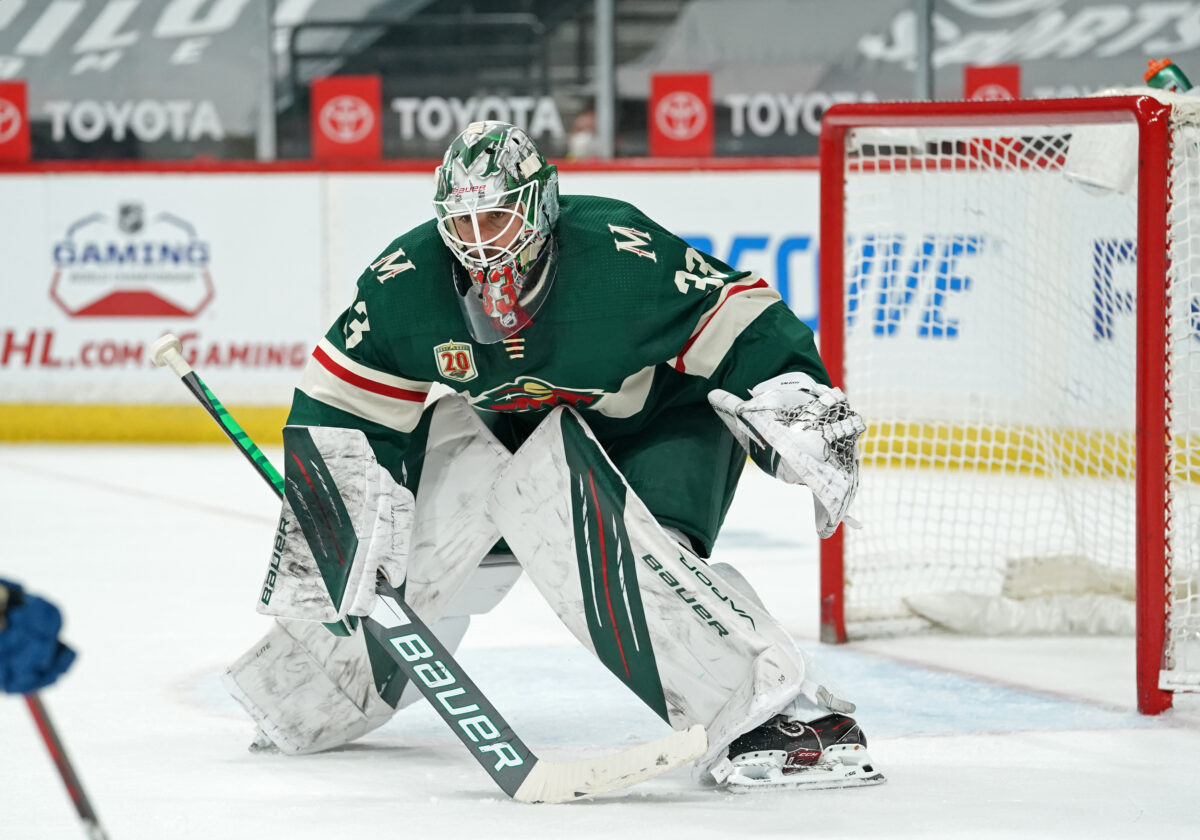The Minnesota Wild have found success at the start of the 2021-22 NHL season, going 8-3-0 over their first 11 games of the year. In fact, that record is good enough to have them sitting first place in the Central Division, with 16 points as of Nov. 9. There have also been a lot of “smaller” stories to celebrate, ranging from Kirill Kaprizov beginning to heat up after a slow start, to Minnesota getting contributions from its depth to solid defensive play all around. With that being said, one area that the Wild have been struggling with is goaltending.
In the 2020-21 season, the Wild could trust Cam Talbot and Kaapo Kahkonen to put on consistent performances in net more often than not. Unfortunately, that hasn’t been the case this season. Minnesota was tied for the 11th-best save percentage (SV%, .907) and placed 15th when it came to goals-against average (GAA, 2.86). Fast forward to the current season and the Wild own a .889 SV% (28th) and 3.00 GAA (T-25th). Even if Minnesota is first in its division, it’s hard to imagine the team sustaining its success with those goaltending numbers.
That’s why it’s important to look at what’s going on with the Wild’s goaltenders, as well as a possible solution to these issues.
Talbot Struggling With Inconsistencies
Expectations were high for both Talbot and Kahkonen following the 2020-21 NHL season. The former started 33 games for Minnesota last year, finishing with a 19-8-5 record, .915 SV%, 2.63 GAA and two shutouts. Meanwhile, the younger Finnish goaltender finished his first full-time season by going 16-8-0 with a .902 SV%, 2.88 GAA and his own pair of shutouts. While Talbot had some injury issues last year, however, neither goalie dealt with anything major that could give fans the impression that they’d regress this season.
When it comes to Talbot, he’s started most of the Wild’s games in 2021-22. He’s gone 7-2-0 in his nine starts, which is an impressive feat. The only issue is that his .904 SV% and 2.85 GAA are both his worst since the 2018-19 season. Diving a bit deeper, Talbot has given up at least three goals in five 55.6% of his starts so far. To put things into perspective, he allowed a minimum of three goals in 51.5% of his starts last season. That may not be a huge difference numerically, however, that’s putting a lot more pressure on the Wild’s forwards to score more goals.

The truth is that Talbot has been getting bailed out a few times by his goal support. He’s given up 26 goals so far while also getting 26 goals from his teammates during his starts. For context, 21 of those came during games where he allowed at least three goals. Looking into advanced stats, Talbot’s 2.85 GAA is -0.27 worse than his expected goals against average (xGAA) of 2.58, which further proves that he’s been slacking.
Related: Wild Check-In: Spurgeon and Kaprizov Make Waves
While it’s entirely possible that the Minnesota skaters can keep bailing him out, that isn’t the type of mindset that a contender should have. The Wild can play more confidently if they know that their starting goaltender can steal them any given game, whether they score two or five goals.
Kahkonen Needs to Prove Himself in Contract Year
On the other hand, Kahkonen hasn’t looked good in his minimal appearances. The 25-year-old backup has started in just two games so far this season, recording a 1-1-0 record with an abysmal 3.63 GAA and 0.860 SV%. Not only that, but his 2.91 xGAA further illustrates how improvements need to be made. Nevertheless, both of his appearances were on opposite ends of the spectrum, with him allowing five goals in a shaky start against the Nashville Predators before allowing just two in a win over the New York Islanders.
Being inconsistent isn’t anything new for Kahkonen. While he showed flashes of brilliance last season, it seemed like every game where he’d stand on his head was followed up with a sub-.900 SV% performance. The thing is that Minnesota knows that he can be really good whenever he’s on top of his game. There were 11 games last season where Kahkonen finished with a save percentage of .910 or better. At the same time, there were 10 instances where it was .900 or worse. He’s still relatively long, so the hope is that he can start figuring out how to string together good starts sooner than later.
The most important reason as to why Kahkonen needs to figure things out is because it’s his contract year. He’ll be a restricted free agent at the end of the season. While the Wild do control his future, there isn’t as much of an incentive to extend him (at least long term) now that soon-to-be 19-year-old Swedish phenom Jesper Wallstedt is in the system. Still, that doesn’t mean that Kahkonen suddenly has no value for Minnesota. On the contrary, actually.
Related: 5 Minnesota Wild Milestones to Watch for in 2021-22
There’s no guarantee that Wallstedt will pan into everything that fans and management hope he’ll be one day. That’s why Kahkonen needs to show the Wild what he’s capable of as soon as possible. Contract years typically push athletes to elevate their game to the next level, which is exactly what needs to happen in this situation. Kahkonen still holds value both as a backup or potential starter, especially with him only being in his mid-20s. Getting him to quickly figure out his abilities will not only benefit the Wild this year but going forward as well.
Wild Need to do Better Dividing Goaltending Starts
One thing that the Wild should try when it comes to their goaltending woes is figuring out a better way to divide games between Talbot and Kahkonen. At the moment, they’re asking one goalie to do a lot more than the other, compared to last year. It’s a small sample size, but Talbot has played just over 81% of starts in the 2021-22 NHL season compared to nearly 59% last year. Yes, he dealt with injury and health issues last campaign, but even when healthy, that sort of split seemed to benefit him. He’s entering the final years of his carry, so his disappointing play this season might be due to Minnesota over exhausting him.

Playing Talbot too much is also detrimental to Kahkonen. His poor play can’t be denied, but it’s hard for a goaltender to build confidence if he’s playing one out of every six or seven games. He may occasionally have a brick wall-like performance, but that can quickly become undone if he has to wait over a week between games. That’s not to say that the duo should rotate every game, however, something closer to a 60/40 split in favour of Talbot is more beneficial. That way, the veteran goaltender can rest more often while Kahkonen gets a chance to prove why he deserves a new contract and more playing time.
The Wild Still Have Time
Goaltending struggles are never a good thing to have, whether it’s at the start of the year or towards the end. Regardless, the Wild are fortunate that their forwards and defensemen have kept them high in the standings. They may not pull that off for a full 82-game schedule, however, Minnesota sitting first in the Central Division means that there is extra time for Talbot and Kahkonen to figure things out. They’ve both proven themselves in the past and there’s no reason why they can’t suddenly bounce back, especially with how the team has played as of late. If the Wild’s goaltending issues are solved within the next few weeks, the team will be taken more seriously around the NHL.